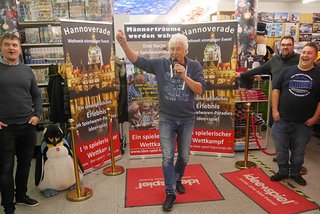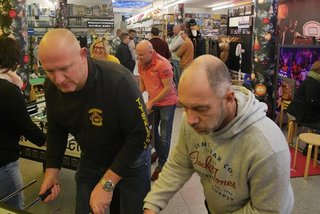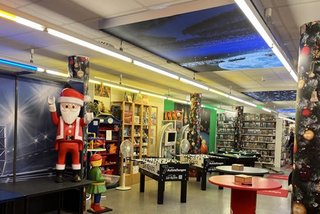
Arousing great emotions at the point of sale
How brick-and-mortar toy retailers can survive
By Peter Budig
The last free space, the last advertising bastion in the toy shop, can be found under the ceiling. “We’ve fine-tuned everything: lower shelves, better music and pleasant scents,” says Heinz Lehmann. All this was done with one aim in mind: “In retail, you’ve got to arouse people’s emotions and sell feelings – that’s the only way to get people to come to you, the only way to increase sales.” And so Lehmann, a toy shop owner for decades, came up with a brilliant idea in the spring of 2022 when he spotted a magical glowing whirlpool in a trendy bathroom shop. “The grey, dreary ceiling has to go,” he thought, and no sooner said than done, he developed a visual concept.
Only with creative experience ideas do brick-and-mortar toy stores have a chance of survival

With some idiosyncratic and very successful marketing ideas, toy retailer Heinz Lehmann has bucked the trend all his life and celebrated some surprising successes time and again – despite adverse circumstances. In the mid-1980s, when Toys “R” Us opened its first shops in Germany, putting enormous pressure on the small-scale brick-and-mortar toy trade, he, the managing director of a wholesale group, reacted and developed a toy “dream world” on 1,500 m2 of shop space. After German reunification in 1990, he bought a toy wholesaler and opened toy shops in the new federal states that were between 200 m2 and 1,500 m2 in size. Called “idee+spiel”, it was a successful concept. When the Internet, with its uncomplicated way of doing business conquered the world, he seized the opportunity to explore new sales channels and founded the very first toy online trading company in Germany in 1994.
Nevertheless, the general industry analysis is still sobering today: despite continuously rising sales in the German toy trade – about 5% annual growth since 2012 – the toy retail trade is now threatened with extinction more than ever before. This has been equally reinforced by shop closures due to the ongoing pandemic. At the same time, online trade is gaining increasing importance. This is how the strategy consultancy FOSTEC & Company, which focuses on digitalisation and e-commerce, analyses the situation. “In a clothes shop, you might still be looking for expert advice, but all you need to buy a board game is one click,” is Lehmann’s sober summing up of the situation. In 2009, he then thought about how he could reach an even wider public and, at the same time, drastically slash advertising costs. And he came up with an amazing idea: “Playing games in the toy shop.”
Competitive fun in the toy shop: you can’t get a better win-win situation

“Little Las Vegas in Hanover?” The slogan from the media is perhaps a little over the top, but the fact is that Heinz Lehmann has created a new source of income with a “men’s dreams come true” concept and put his toy business on a solid footing.
In his toy shop, he installed a competitive games course with eleven challenges to make men’s hearts beat faster: foosball, bocce, Carrera racing, roulette, poker, games of skill... Add to that bottled beer, soft drinks and little snacks, and the event concept of competition, passion and pleasure was complete. These days, it costs €45 to take part. Up to 96 people can take part at the same time – and true heroes are sought and found night after night.
At first, this offer was extended only to men, but women were also very enthusiastic back then – they had the perfect gift for their beloved. Today, and after the idee+spiel shop moved from Hanover’s pedestrian zone to the Calenberger Esplanade just outside the city centre, women’s events are now also the order of the day. The decisive factor in all cases, says Lehmann, is that “in the long term, the events only work in the context of the toy shop, while sales in the toy shop have increased and are stabilising.” You can’t get a better win-win situation.
Shop and events – a solid stronghold – until the pandemic started

The idea was a twofold success, because the press also jumped on the bandwagon: first local print media, then radio and local television, then the major magazines, and television stations from RTL to arte. Heinz Lehmann’s “Toy Event Venue” was the talk of the town. It was a scoop in terms of advertising and the turnover from the events covered the rent of the toy shop. The 72-year-old entrepreneurial activist and his team handled the afternoon and evening events, which were also booked by ever larger companies. His partner Schäfer, a passionate toy retailer, organised the shop. A solid stronghold, this community…until the pandemic started.
The next bright idea: picture dreams on the ceiling
How could he draw attention to his shop again after the restrictions of the pandemic period? How to mobilise the public again? How to arouse great emotions? This was the task Heinz Lehmann was faced with at the end of 2020. True to his experience that “best publicity is media publicity”, he sought new opportunities. But how do you come up with such a coup again? With proven instincts and professional advertising partners, Lehmann conceived his next great idea: he developed a photo light show for the grey ceiling in the toy shop. “In spring, they were all nature and landscape pictures. In the summer, we replaced them with images of the summer, and now sentimental Christmas scenarios enliven the shop.” What can one say? “Twenty per cent more turnover in the brick-and-mortar toy trade and the events have shot up anyway,” beams Heinz Lehmann, who, one may assume, is just as pleased with the profit as with the fact that he has once again been successful with creative ideas that buck the trend.
Interview with Heinz Lehmann
Arte broadcast an interview with Heinz Lehmann and his business partner Volker Schäfer on 15 December 2020. (only in german)
About the Author:
Peter Budig studied Protestant theology, history and political science. He worked as a freelance journalist, headed up the editorial department of a large advertising paper in Nuremberg for ten years and was the editor of Nuremberg’s Abendzeitung newspaper. He has been freelancing again since 2014 as a journalist, book author and copywriter. Storytelling is absolutely his favourite form.


